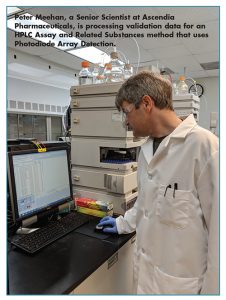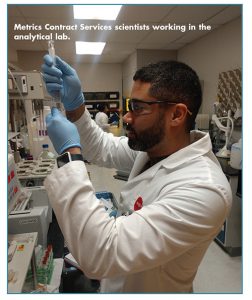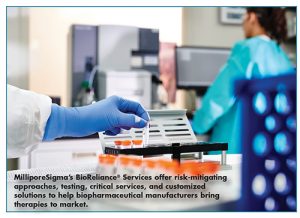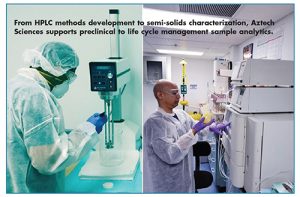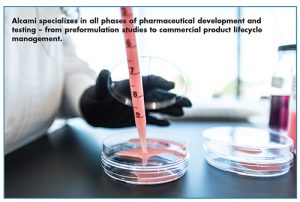Issue:January/February 2020
SPECIAL FEATURE - Outsourcing Analytical Testing: Novel Services Elicit Consistent, Quantifiable, & Faster Results
The global pharmaceutical analytical testing outsourcing market size is projected to reach $10.4 billion by 2026, according to a recent report by Grand View Research, Inc. Clinical bioanalytical testing services is projected to be the largest service segment over the forecast period.1 And with many big companies lacking the required manufacturing set-up and expertise to carry out in-house testing services, outsourcing is essential to remain competitive. In addition, ancillary services, such as registration, storage and testing, process and facility validation, and cleaning validations, are being outsourced and will only boost the market growth. This exclusive annual Drug Development & Delivery report describes some novel analytical testing services aimed at ensuring quality and safety, and in some cases, speeding the process and saving money.
ARL Bio Pharma: Test Services for Drug Discovery, Launch, and Access
ARL Bio Pharma is a contract laboratory that provides analytical and microbiological testing to pharmaceutical companies and research scientists. The laboratory provides guidance and test services for all phases of the product lifecycle following USP, FDA, and ICH guidelines. “ARL’s approach to industry quality requirements, analytical systems, and data integrity provides the scientific results needed to launch small molecules, biologics, proteins, and peptides to market,” says Thomas C. Kupiec, PhD, President and CEO, ARL Bio Pharma. “Our team maintains awareness of quality, safety, and changing regulations to comprehensively understand clients’ drug product goals, provide results, and help interpret data for each stage of the lifecycle.”
Analytical method development and validation is important to develop safe and effective drug products and improve efficiencies in the drug discovery process. ARL validates analytical methods based on ICH and USP guidelines and high-quality industry practices. Method parameters may include precision, limit of detection, limit of quantitation, accuracy, linear range, specificity, robustness, system suitability, ruggedness and freeze-thaw. “Analytical method parameters help establish accurate and reliable acceptance criteria,” says Dr. Kupiec.
ARL’s laboratory also works with pharmaceutical companies to perform Y-site compatibility studies. These studies ensure that the mixing of two product formulations does not impact the physical or chemical properties of the drugs. Dr. Kupiec says: “The data is used in product packaging so administrators know what other drug products can be clinically administered with the packaged product to ensure patient safety.”
Ascendia Pharmaceuticals: Phase-Appropriate Method Validation
Ascendia Pharmaceuticals provides analytical support for all stages of the drug development process, from discovery to approval. Analytical support includes method development, method validation, and testing drug products, drug substances, excipients, components, etc.
“Ascendia’s analytical support model is based on providing our clients with reliable data,” says Muhammad Asif, PhD, Sr. Director, Analytical R&D and Quality Control, Ascendia Pharmaceuticals. “To ensure accurate results, Ascendia has developed internal systems and processes that fulfill this promise throughout the development process.”
As the drug development process is becoming more involved and sophisticated due to increasing complexity of new drug moieties, Ascendia has developed a niche in developing marketable formulations of drugs that otherwise have low solubility and/or bioavailability, claims Dr. Asif. “Development of good analytical methods not only has helped streamline the formulation development, but, in some cases, showed that a stable formulation was indeed feasible,” he says. Ascendia uses a phase-appropriate method validation process. For example, during early development, accuracy and specificity of a method are ensured, while during later stages of product development, a full method validation package is offered for NDA/ANDA submissions that fulfils ICH and FDA requirements. Ascendia also offers a full method transfer package to a commercial Quality Control laboratory.
Catalent: A One-Stop Lab for Stand-Alone Method Development
The analytical services division at Catalent conducts analytical chemistry and microbiology tests to determine and ensure the identity, purity, potency, and performance of drug substances and drug products. In addition, this division provides stand-alone method development and validation, structural characterization (including extractables/leachables and heavy metals/elemental impurity testing), solid state preformulation, and clinical and commercial-scale stability studies, in compliance with international standards. Catalent’s analytical chemists and technicians handle highly potent, cytotoxic, light-sensitive, temperature-sensitive, and DEA-regulated compounds.
In addition to its suite of small-molecule testing capabilities, Catalent also possesses large-molecule capabilities, including bioassay, binding assay, master/working cell bank storage, and sterile formulation development. And, Rekha Patel, Director, Biologics Analytical Solutions, adds that Catalent’s Kansas City team has comprehensive capabilities, enabling a one-stop lab for clients, minimizing the client’s need to manage logistics with multiple labs.
But when it comes to managing regulations, Catalent has made some internal adjustments. “We have seen changing regulations in the area of testing/qualification of plastic packaging systems and components for pharmaceutical use,” says Dontae Solomon, Director, Analytical Development, Catalent. “A recent review of our existing USP 661.1/661.2 capabilities led to us developing a plan to generate a preset quote that could cover all the variations of the testing that might be needed.”
Mr. Solomon explains that USP 661.1/661.2 comes into full effect in May 2020, so requiring addressing shortly. The chapters have various LC, GC-HS, and TLC methods that are specific to the plastic being tested and the additives in the formulation. Catalent is currently establishing whether verifications are necessary, whether these could be performed in advance using an in-house method, or whether the method standards and controls in the chapter obviate the need for a separate verification.
Frontage: Integrated Service for Drug Development
The Frontage analytical service department in its CMC division offers a variety of analytical testing to support API and reference standard characterization, preformulation, formulation, and finished drug product characterization. In addition to performing regular pharmaceutical analysis for both small and large molecule products, Frontage also performs special analytical tests, such as unknown degradation product identification, extractable/leachable analysis, host cell protein, and protein mapping. Other services include diffusion studies for semi-solid product development, and ICP/OES and ICP/MS tests for metal analysis.
With metal impurity testing being a recently added requirement for drug products, Frontage used both ICP/OES and ICP/MS instruments to test one client’s injectable product on multiple elements. “Together, with other chromatographic and wet chemistry tests, Frontage completed full ICH stability assessment on the product and leachable tests for the container/closure,” says Kang Wang, Vice President of Analytical Services. “A comprehensive data package supported a successful NDA submission.”
And, as a full-service analytical lab, Frontage developed and validated an in vitro release test method for one customer’s ointment product. Mr. Wang says Frontage supported product selection activities and a final in vitro bioequivalence study between reference listed drug and test products per Good Laboratory Practice regulation. The study results helped the client gain ANDA approval from FDA, he says.
Mr. Wang adds that Frontage’s analytical lab is continually evolving with new technology/instruments to meet challenges required for product development. “A highly sensitive accurate mass spectrometer will be installed in our lab in December,” he explains. “With this addition, we can test low-level genotoxic impurity to satisfy regulatory requirements.”
Metrics Contract Services: Methods for Testing Drug Substance & Drug Product
Metrics Contract Services has 150 chemists who provide method development, method validation, sample analysis, release testing, stability study storage and testing, physical characterization, trace metals analysis, and microbiology. A dedicated quality control laboratory to test commercially manufactured drug product made at its Greenville facility and a 17,000 square-foot facility provides storage space for clients’ products requiring specified environmental conditions.
Once development is complete, the validation group works with clients to develop a phase-appropriate validation for the methodology that is in line with current FDA guidelines. Speaking of guidelines, the implementation of USP 232/233 led Metrics Contract Services to expand its metals analysis capacity by purchasing an additional ICP-MS and expanding its metals staff.
Metrics Contract Services performs a variety of analysis testing, including charged aerosol detection (CAD). As an example, one client asked Metrics Contract Services to perform the release testing of Phase II clinical trial material and provided a validated HPLC method for the assay and identification of Compound X by UV detection. The method demonstrated consistent chromatography with the validating laboratory and met the requirements for precision and linearity.
During UV analysis, one peak was observed to have no impurities, explains Holly Horton, Senior Analytical Chemist, Metrics Contract Services. A review of the chemical structure of Compound X showed that no major chromophores were present and that the compound was a maleate salt. “This observation, as well as the lack of impurities, led our team to conduct another analysis using CAD,” Ms. Horton says. That analysis showed two peaks, suggesting the peak identified as Compound X in the original method using UV detection was the maleate salt and not the active ingredient. The identities of both peaks were later confirmed by HPLC-MS.
A thorough investigation into the structure and chromatography of Compound X revealed that UV detection was not a suitable means for quantifying the main compound or the impurities, Ms. Horton says. Analysis performed using CAD displayed the presence of two peaks, which drew concern to the initial identification of Compound X by UV detection. LC-MS was used to properly identify these peaks.
“These findings resulted in the development and validation of HPLC-CAD methods for assay, identification, related substances, and dissolution of Compound X prior to the release testing of Phase II clinical trial material to ensure the safety and efficacy of the clinical trial material,” she says.
MilliporeSigma: Using LC-MS As An Orthogonal Approach To Verify ELISA Data
MilliporeSigma provides a comprehensive range of analytical, bioanalytical, and biosafety testing as part of its BioReliance® Services portfolio for biopharmaceuticals. Using a combination of analytical techniques and cell-based immunological assays, MilliporeSigma provides clients with a detailed understanding of the physical and structural attributes of their drug and its biological activity. “Our experience in method development and validation enables us to support projects from early development through to GMP lot release,” says Andrew Bulpin, Head of Process Solutions, MilliporeSigma.
In addition to analysis of the molecule of interest, there is a regulatory requirement to characterize the various process-related impurities present in the drug substance or drug product. These residuals can arise from both upstream and downstream processes. Of particular concern are host cell proteins (HCPs), which pose a potential risk to patient safety and product stability.
“Generally, the level of HCPs is quantified by an enzyme-linked immunosorbent assay (ELISA) by using either a generic kit-based approach in the early stages of development, or by using polyclonal antibodies specific to the process,” explains Mr. Bulpin. “This yields a numerical value equating to the total quantity of HCPs that produce an immunological reaction. However, it does not distinguish between the different HCPs present, some of which may cause concern. Also, it is necessary to demonstrate sufficient antibody coverage against all potential HCPs, which provides an additional challenge. There is increasing awareness of the limitations of HCP quantification for ELISA by regulators and manufacturers alike, leading to a need for orthogonal approaches.”
Recently, MilliporeSigma established a liquid chromatography-mass spectrometry (LC-MS) platform for HCP analysis. In this approach, the sample is first digested using trypsin and the resultant peptides are analyzed by LC-MS. Proteins are then identified and quantified on the basis of the peptides detected. Mr. Bulpin says: “The combination of two-dimensional liquid chromatography and high-resolution mass spectrometry overcomes the analytical challenge of detecting low (ppm) level HCPs in a high concentration of therapeutic protein.”
He says that a key benefit of the LCMS approach is the ability to identify, as well as quantify, individual HCPs. “This knowledge enables a proper evaluation of the potential risk of specific residual HCPs,” he says. “Furthermore, as a platform method, it can be applied to different products/processes without the need for extensive development, unlike an ELISA that requires specific antibodies to be raised.”
The relative simplicity and ease of validation means that ELISA is unlikely to be replaced by LC-MS as a lot release test for HCPs in the near future. However, as regulators demand a better understanding of a product/process as part of the principle of Quality by Design, it is likely that more thorough characterization of the HCP profile will be required. “Several of our clients are now looking to use LC-MS as an orthogonal approach to verify their ELISA data and demonstrate suitable coverage,” says Mr. Bulpin.
Quotient Sciences: Biorelevant Dissolution Assesses Different Formulations
Quotient Sciences develops and manufactures a range of dosage forms and conducts analytical testing to support preformulation, drug product formulation development, clinical, and commercial manufacturing operations. Analytical techniques such as DSC, TGA, XRPD, and Raman for solid state characterization are used. For drug product development and release, assay and content uniformity testing are typically performed via HPLC. UV, dissolution, a PSD, emitted dose testing, enzyme assays, and microbiological testing are also routinely performed. Some novel techniques are also used to support formulation development, such as biorelevant characterization.
Quotient Sciences routinely uses biorelevant dissolution testing (using biorelevant media) as an analytical tool for assessing the performance of different formulations. A recent study performed on behalf of Boston Pharmaceuticals Inc. involved developing three different formulations of BOS172767, representing different strategies (micronized capsule, lipid capsule, and spray dried dispersion tablet). “We assessed each formulation in a pH shift biorelevant dissolution test using fasted state simulated gastric fluid and fasted state simulated intestinal fluid,” says Justin Holland, Senior Director (Analytics), Pharmaceutical Sciences, Quotient Sciences.
Data presented at the 2019 American Association of Pharmaceutical Scientists Meeting in San Antonio, TX, showed that dissolution testing demonstrated that all three formulation technologies had a greater release compared to the immediate release (IR) reference formulation. “All three formulations were dosed in a Phase I clinical study that successfully identified the micronized capsule as the new lead formulation with superior exposure to the IR reference formulation,” he says. Furthermore, a Level C in-vitro in-vivo correlation (IVIVC) was achieved with the biorelevant dissolution test, providing valuable information for future formulation development and setting of product specifications.
Recipharm: Stand-Alone Analytical Service Meets Timelines, Saves Costs
In addition to offering analytical services, Recipharm launched Recipharm Analytical SolutionsTM in 2019. The stand-alone service supports pharmaceutical companies with capacity for their analytical requirements, including method development, method validation, and stability program design and implementation. “By providing additional capacity for customer QC labs, we can reduce their timelines and any associated costs,” says Maria Lundberg, Vice President of Global Analytical Development, Recipharm.
One leading pharma company came to Recipharm to sub-contract the routine analysis of a marketed antibiotic product. During this standalone analytical project, Recipharm established a team to conduct two series of experiments at the customer’s site and one of Recipharm’s facilities.
“Due to the development and validation work carried out in parallel with the stability study, we met the intended timelines established at the start of the project,” says Ms. Lundberg. “We were also able to meet all the requirements of a quality control routing analysis.”
In addition to launching the standalone analytical solutions offering, the company recently invested into expanding its laboratories in Bengaluru, India. “At Recipharm, we use a QbD approach to guarantee high quality, robust, and transferable methods,” says Ms. Lundberg. “And, as an end-to-end CDMO that supports customers globally on a range of projects, we develop methods with commercialization in mind to minimize delays later down the line.”
Aztech Sciences Inc.: Remaining Versatile In Handling Complex Formulations
Aztech Sciences Inc. provides scientific rationale and customized analytical services to support analytical testing for pharmaceuticals, preformulation, and formulation, analyzing pharmaceutical raw materials, formulation prototypes, drug delivery systems, and finished products.
“Understanding that each client’s project requirements vary, our approach is not a one- size-fits-all methodology, so we are focused and versatile to the project deliverables,” says Alvin Persad PhD, President/Co-founder, Aztech Sciences Inc.
He says that Aztech also handles complex formulations, where the importance of recognizing a robust extraction process is essential to sample preparation and reproducibility. “Identifying the stages of the project’s complexity, timelines, and milestones will allow for the level of scientific creative rationale to proceed with the project, as in the case of an early-stage analytical method development followed by pre-validation testing, eventually leading to a full method validation,” he explains.
One Aztech client expressed concerns about an assay result and needed Aztech to perform a different chromatographic assay method to correlate the results. Note that this molecule does not have any chromophores. Dr. Persad says that Aztech suggested that an HPLC assay method could be developed using a refractive index detector to determine the peak (molecule) of interest. “The extraction, sample preparation, and HPLC assay were completed within a week and the client was able to correlate and confirm that both assay results are within specification from two completely different chromatographic methods,” he says.
ENCO Pharmaceutical Development, Inc.: Method Remediation Leads To Successful Testing & Materials Release
Analytical services at ENCO Pharmaceutical Development, Inc (EPDI) are at the core of company operations, moving customers from early phase to commercial with phase-appropriate qualification and validation. Full instrumental capabilities include assay, related substances, and impurities, using HPLC, GC, IC, and ICP-MS. Additional offerings include full compendia testing, dissolution, disintegration, particulate testing, and thermal characterization.
While method Development and validation have been long-standing capabilities at ENCO, the application of Quality by Design (QbD) principles to analytical methods has increased their importance. “QbD requires more up-front investment in development, but returns significant benefits when implemented correctly,” says Richard Camp, President of EPDI. “A strong knowledge of method capability gained though QbD is key to ensuring ongoing method suitability as projects and products evolve.”
One project involved a client that was implementing a novel formulation that included several non-compendial raw materials, each of which was subject to a significant amount of analytical characterization. Mr. Camp explains that gaps were identified in the supplier’s technical packages related to analytical method validation. “EPDI performed an assessment of the existing validation information to determine if it was either incomplete or noncompliant with current industry practices, performed method remediation, and subsequent validation. These activities led to the successful testing and quality release of 13 materials and 30 methods, both at the lab and manufacturing facility.”
Recro Gainesville: QbD Method Development Results In Shorter Run Times
As a CDMO, Recro Gainesville offers method development, validation, and routine testing using analytical techniques needed for oral solid dosage form development, release, and stability testing. The industry’s increasing awareness about product quality, safety, and changing regulations has re-emphasized the need for strong analytical science capabilities. As such, Richard Sidwell, PhD, Senior Vice President and Chief Scientific Officer, Recro, says the company stays up to date on new and changing regulatory requirements, and provides support for successful regulatory submissions and drug product approvals. Some examples include modifying or developing new sensitive and selective methods for low level impurities, setting specifications based on the ICH guidelines, designing forced degradation studies to understand the degradation pathways, and conducting stability studies to provide shelf-life projection for client projects and subsequent regulatory submissions.
“In addition, we write and review CMC sections, including justification of specifications (JOS) for NDA submissions using various statistical tools,” he says. Analytical scientific staff use a variety of column chemistries (reverse-phase, chiral, HILIC, size-exclusion, and normal phase) for pharmaceutical applications to support the development and characterization work.
To accelerate the method development timelines for its clients, Recro recently acquired a Quality-by-Design (QbD) method development system that can run six different columns and scout several unattended conditions (gradient slope, % organic, temperature, flow, pH, selectivity, total run time, etc.) to develop a robust new method, explains Dr. Sidwell. “Using this QbD system and appropriate Design of Experiments (DOE), we can decrease the total method development times to less than a week compared to a traditional one-factor-at-a-time (OFAT) approach of six to eight weeks,” he says. “Also, the QbD approach allows us to define the design space, which is very useful for future method changes, if required, without any additional method development time.”
Recently, one Recro client requested use the same analytical method for both its API and finished dosage formulation of various strengths (5 mg, 10 mg, 20 mg, and 40 mg) to monitor and quantitate all process-related and other related substances. Dr. Sidwell explains: “By evaluating a shorter column from the same column type, and optimizing the mobile phase gradient, we decreased the run time by over 70% without changing the selectivity of the API method for more than 10 related substances. We successfully validated the method for this client’s drug product as well, which resulted in substantial cost savings in addition to the shorter run time.”
Frontida Biopharm, Inc.: Quality & Safety With Regulatory Compliance
Frontida Biopharm’s analytical services include method development, troubleshooting, validation, qualification, product testing, stability storage, and testing for products from IND, NDA, and ANDA to commercialization. APIs, excipients, finished products, and packaging materials can all be tested, and Frontida provides reverse-engineering services and physical characterization. Frontida’s analytical services are expanding beyond supporting the development and technology transfer programs to provide stability storage and testing, material release, and individual testing.
Increased requirements for quality and product safety have made development capacity more important. “Heightened quality requirements for tests not only increase the cost of a product because of a higher batch failure rate, but the regulatory risk also expands and could result in deficiency letters,” says Tony Liu, Vice President, R&D, Frontida. “Response to a deficiency letter could be costly and delay product approval. Both will result in financial losses, so ensuring that testing is performed correctly the first time is critical.”
Frontida’s ability to rapidly correct potential issues can be illustrated by its work with one client that produces bisect scored tablets. “To comply with regulations, we needed to conduct a splitting study,” explains Dr. Liu. “The client’s original validation protocol did not cover the ranges for this type of study. We immediately informed the client and worked with them to modify the dissolution method to cover the very low concentration of the quarter tablet dissolution profile range. The method was successfully validated and the product has been filed. Due to a series of successful FDA inspections over the last three years, FDA has waived the pre-approval inspection and the product is currently on the market.”
Alcami: Expanding Services to Enhance Support of Complex Formulations
Alcami’s end-to-end analytical testing platform supports clients’ programs through every stage of a product’s life cycle, from early-phase development activities to commercial support for both small and large molecule products. As a fully integrated CDMO, Alcami has expanded its services by adjusting to market and regulatory changes. The expansion of its Extended Workbench offering, development of a quality system with third-party audit reports, and the addition of capabilities like rapid sterility testing address client needs.
“Our Extended Workbench is a Full-Time Equivalent (FTE) program tailored to a client’s specific needs,” explains Michael Freeman, Commercial Development – Laboratory Services. “Dedicated employees focus solely on individual client projects to provide a flexible and controlled outsourcing laboratory service package. An Extended Workbench program can be customized based on product phase and number of products.” Clinical phase development platforms can be designed to be adaptable, granting clients the freedom to adjust priorities based on their needs and results. Programs can also be designed for short-term use with a fixed-cost schedule, providing cost control during a product’s riskier development phase, says Mr. Freeman. Conversely, the Extended Workbench also provides clients with a single vendor laboratory resource for their analytical needs during the established phases of a product and portfolio. He says: “In these stages, where quality control analysis is needed, clients can control their costs and priorities while still performing routine product release, stability, and raw material evaluations.”
Alcami’s efforts to expand its range of services include the introduction of rapid sterility technology and biosimilar analytical capabilities. “We can release clients’ products to market faster, reduce inventory holding times, and provide more robust computer-generated sterility results, eliminating subjectivity and individual analyst observations,” he continues. “Also, as the industry continues to transition to more complex formulations and more biologics come off-patent, our ability to handle complex entities in the coming years is critical.”
REFERENCE
- Pharmaceutical Analytical Testing Outsourcing Market Worth $10.4 Billion By 2026, Grand View Research, April 2019, https://www.grandviewresearch.com/press-release/global-pharmaceutical-analytical-testing-outsourcing-market.

Cindy H. Dubin is an award-winning journalist who has been reporting on the pharmaceutical industry for more than 18 years about a variety of topics, including formulation development, drug delivery, and drug quality.
Total Page Views: 8440





